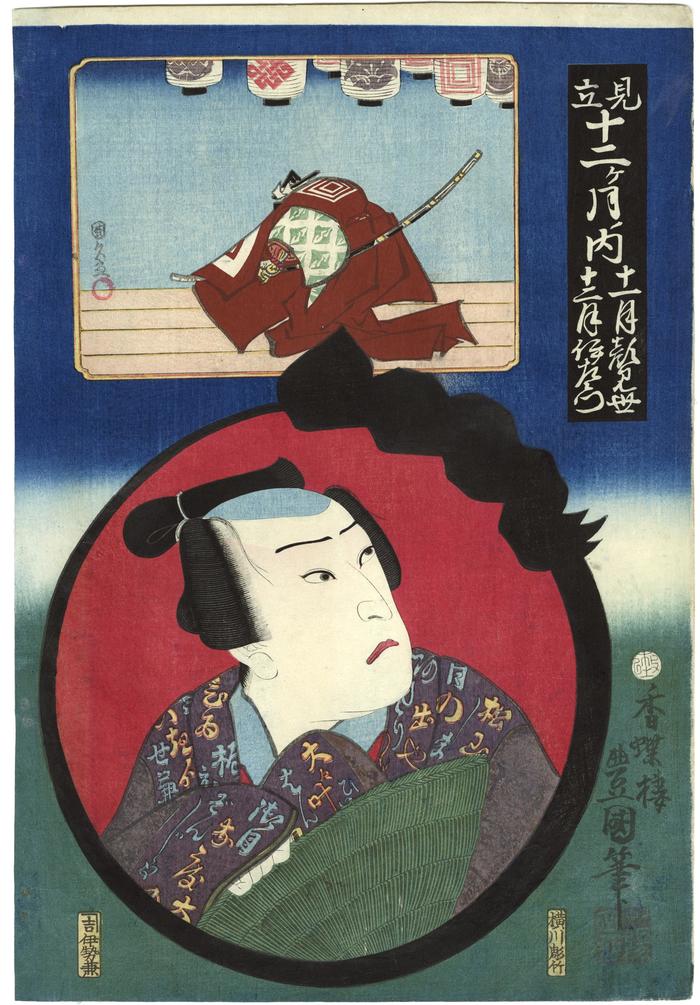Utagawa Kunisada (歌川国貞) / Toyokuni III (三代豊国)
(artist 1786 – 01/12/1865)
Utagawa Kunihisa II (二代目]歌川国久)
(artist 1832 – 1891)
Kataoka Nizaemon VIII as Izaemon (伊左衛門) at his December kaomise (顔見世) in 'A Parody of the Twelve Months' (Mitate ju ni kagetsu nouchi - 見立十二ヶ月ノ内) representing the 11th and 12th months
1859
9.875 in x 14.5 in (Overall dimensions) Japanese woodblock print
Signed: Kōchōrō Toyokuni hitsu
(香蝶楼豊国筆)
Inset signed: Kunihisa ga (国久画)
Publisher: Iseya Kanekichi (Marks 145 seal: 21-059)
Carver: Yokogawa Takejirō
Waseda University
Waseda University - the complete set
Ritsumeikan University
Edo-Tokyo Museum A Parody of the Twelve Months Mitate ju ni kagetsu nouchi 「見立十二ヶ月ノ内」 November, Kaomise Performance, and December, Izaemon, 「十一月顔見世 十二月伊左衛門」
Inset by Kunihisa II of Shibaraku.
****
Scholten Japanese Art wrote of this print:
"A portrait of the actor Kataoka Nizaemon VIII (1810-1863) depicted within a frame formed by the Toshidama seal of the Utagawa school of artists. The actor is portrayed in the role of Fujiya Izaemon from the play Kuruwa Bunsho, a rare example of a love story with a happy ending. The story revolves around the love-sick Izaemon who has been disinherited by his mother because of his inappropriate love for Yugiri, the most beautiful courtesan in Osaka. Despite of a period of separation and bouts of intense jealousy, the lovers manage to reunite, and in a surprising turn of events, Izaemon's mother forgives him, and thus he is financially restored as well."
"The inset panel by Kunihisa II (1832-1891) illustrates an actor presenting a kaomise (lit. 'face-showing') performance of the famous role known as Shibaraku. During the Edo period, Kabuki actors would sign one-year contracts with the theaters which start in November and ends in October. The annual kaomise was an important performance that took place in November to introduce the actors for the upcoming season. As one of the most famous and dynamic scenes, 'Shibaraku!' (lit. 'Wait a moment!') was frequently utilized for the kaomise. By the late Edo period actors' contracts were increasingly open-ended and kaomise performances became a rarity.
****
Barbara E. Thornbury noted that starting with Danjūrō II the kabuki season opened in 1714 with a production of Shibaraku coinciding with the kao-mise or 'face-showing ceremony'. Danjūrō I had performed in Shibaraku previously, but not with the opening of the season. Thornbury also noted that productions of this play were recreated every year and therefore were never exactly the same until the script was codified in print in 1895.
Iseya Kanekichi (伊勢屋兼吉) (publisher)
Kataoka Nizaemon VIII (八代目片岡仁左衛門: 1/1857 to 2/1863) (actor)
mitate-e (見立て絵) (genre)
